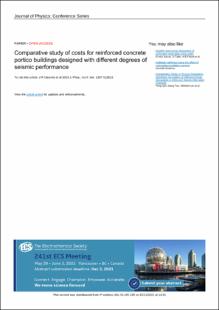Comparative study of costs for reinforced concrete portico buildings designed with different degrees of seismic performance
...
Rojas Suárez, Jhan Piero | 2019-06-27
The Colombian regulation of earthquake resistant construction NSR-10 establishes that the seismic-resistant capacity of a building must be classified according to three degrees of energy dissipation: Special energy dissipation, moderate energy dissipation and minimum energy dissipation. The dimensioning and detailing requirements for structural elements that are demanded according to each grade depend on the need to withstand earthquakes in the inelastic range according to the seismic hazard zone in which the structure is located. This work presents an analysis of the incidence of the requirements of each degree of energy dissipation on the costs of multi-storey building structures. For this, the structural analysis and design of four building configurations (2, 3, 4 and 5 floors) for each minimum energy dissipation, moderate energy dissipation, and special energy dissipation grade has been carried out and the quantities of work with their respective total cost have been determined. As a general conclusion, it can be stated that the cost of building a structure that has special energy dissipation capacity for a given building can be twice that of a structure that has minimum energy dissipation capacity for the same building. On the other hand, it was observed that in order to guarantee a rigidity comparable to that of the other models analyzed, the system of reinforced concrete portal resistant to moments for DES level requires large column dimensions in the case of buildings of four or more floors, which suggests that other types of more efficient elements should be used in the vertical seismic resistance system.
LEER










